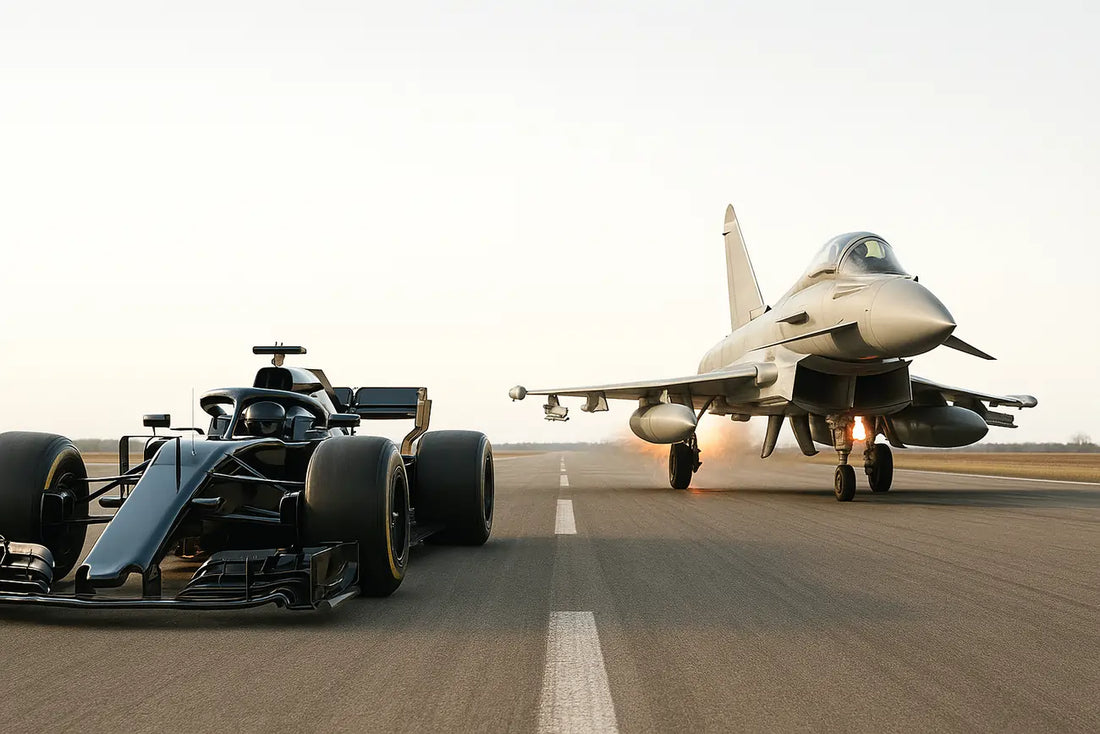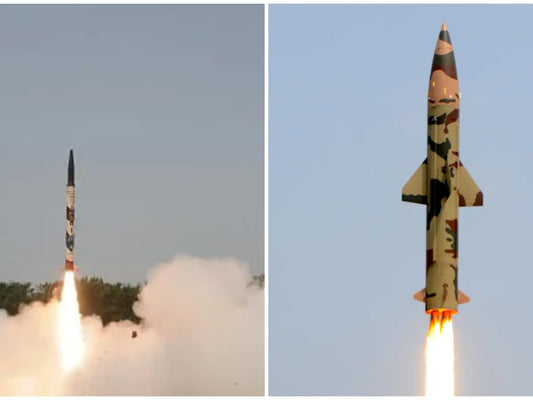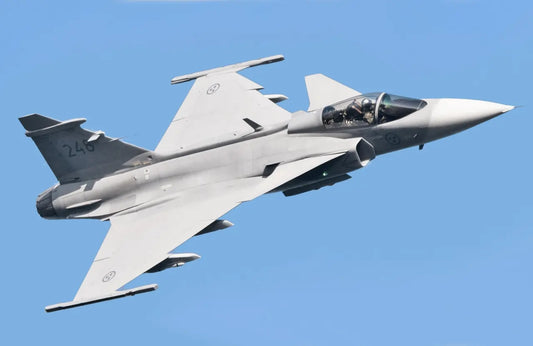Analyzing the Speed Showdown: Formula 1 Cars vs. Fighter Jets

The intriguing question of whether a Formula 1 car can outpace a fighter jet brings together the thrilling realms of motorsport and advanced aviation. While it may initially seem like an unconventional comparison, with one machine designed for high-speed ground maneuvering and the other for supersonic flight, closer examination reveals distinct performance characteristics.
Real-world demonstrations, engineering insights, and performance metrics highlight a nuanced perspective: Formula 1 cars excel in acceleration and short bursts, while fighter jets lead in maximum speed and endurance. This article explores the mechanics, historical encounters, physics, and broader implications of such a matchup, supported by verified data and expert opinions.
The Machines: Engineering Marvels Compared
Formula 1 cars represent the apex of open-wheel racing, adhering to stringent FIA guidelines that prioritize safety, performance, and innovation. The 2024 models of F1 cars are equipped with 1.6-liter turbocharged V6 hybrid engines, delivering over 1,000 horsepower through a combination of internal combustion and electric energy recovery systems. Their construction features lightweight carbon-fiber bodies, advanced aerodynamics, and large tires, which allow exceptional grip and handling. However, these features mainly enhance cornering abilities, while the downforce-generating wings create drag that restricts top speeds on long straights.
Conversely, fighter jets, such as the F-15 Eagle or F-22 Raptor, are engineered for air dominance, reconnaissance, and combat roles. With twin turbofan engines and afterburners, these jets generate thrust significantly exceeding their weight, enabling supersonic flight. For instance, the F-15 has an empty weight of approximately 31,000 pounds but can produce up to 29,000 pounds of thrust per engine, facilitating rapid ascents and agile maneuvers. Operating in three dimensions, jets are unimpeded by road friction, yet require longer distances to achieve their peak speeds due to takeoff procedures and air resistance at low altitudes.
To illustrate the differences, consider the following table of key performance metrics:
| Metric | Formula 1 Car (Typical Modern) | Fighter Jet (e.g., F-15 Eagle) | Notes |
|---|---|---|---|
| Top Speed | 210-230 mph (race average); Record: 231.4 mph (Valtteri Bottas, 2016 Mexican GP) | Mach 2.5 (1,650 mph) | F1 limited by drag and tires; Jet at high altitude with minimal resistance. |
| Acceleration (0-60 mph) | ~2.6 seconds | ~3-4 seconds (from standstill, but jets start rolling) | F1's traction gives edge in sprints. |
| Power Output | ~1,000 hp (hybrid) | ~58,000 lbf thrust (twin engines) | Thrust vs. horsepower; jets convert to effective hp in flight. |
| Weight | ~1,760 lbs (including driver) | ~31,000 lbs (empty) | F1's low weight aids agility. |
| Operational Environment | Ground tracks, limited by friction and corners | Air, with 3D maneuverability | Jets unrestricted by terrain. |
This table highlights why direct comparisons are challenging: F1 cars are optimized for circuits, while jets perform best in open skies where their full potential can be unleashed.
Speed Metrics: Breaking Down the Numbers
The evolution of F1 top speeds has been influenced by technological advancements. During the 1980s, turbocharged engines propelled cars to over 220 mph, but subsequent safety regulations, including the introduction of grooved tires in the 1990s, limited their speeds. Currently, the record for the fastest race speed is 372.5 km/h (231.4 mph), achieved by Valtteri Bottas in a Williams at the 2016 Mexican Grand Prix. The track's high altitude of 7,500 feet contributed to reduced drag and enhanced speeds. Beyond official races, a modified Honda RA106 reached 397.36 km/h (246.9 mph) at the Bonneville Salt Flats in 2006, although this does not represent typical F1 conditions.
In stark contrast, fighter jets achieve significantly higher speeds. The F-15 Eagle, active in numerous air forces, can reach Mach 2.5 (1,650 mph), while the stealthy F-22 Raptor achieves Mach 2.25 (1,500 mph) and can sustain supersonic speeds without afterburners at Mach 1.8. Even older models like the MiG-25 Foxbat, now with limited modern use, can attain Mach 2.83 (1,900 mph). These velocities are attainable at high altitudes where air is thinner; at sea level, drag reduces them, but jets still surpass F1 cars by a substantial margin.
When it comes to acceleration, the scenario changes. F1 cars can accelerate from 0-100 km/h in approximately 2.6 seconds due to their grippy tires and low inertia. Jets, which start from a runway roll, take longer initially—an F-16 might require 10-15 seconds to reach 200 mph—but once airborne, their thrust dominates.
Famous Races: When Ground Meets Sky
Promotional stunts have often seen these machines compete against each other on airport runways for drag races. These events demonstrate that context is crucial: short distances play to F1's strength at launch, whereas longer distances allow jets to excel.
One notable encounter occurred in 2003 at Grosseto's Baccarini military airport in Italy. Michael Schumacher, recently crowned with his sixth world title, drove the Ferrari F2003-GA against a Eurofighter Typhoon piloted by astronaut Maurizio Cheli. The event included three rounds on a wet runway:
- 600 meters: Ferrari won (9.4 seconds at 294 km/h) vs. Typhoon (9.6 seconds).
- 1,200 meters: Typhoon won (14.2 seconds) vs. Ferrari (16.7 seconds at 308 km/h).
- 900 meters: Typhoon won (13 seconds) vs. Ferrari (13.2 seconds at 305 km/h).
The Typhoon's superiority in longer segments highlighted its acceleration advantage once it gained momentum, despite the Ferrari's quicker start. Schumacher remarked on the challenge posed by the wet conditions, which affected traction.
In 2014, Daniel Ricciardo raced a Red Bull RB10 against an F/A-18 Hornet piloted by Flight Lieutenant Michael Keightley at an Australian RAAF base. The F1 car initially surged ahead due to its superior launch, but the Hornet's afterburners activated mid-race, allowing it to overtake. Ricciardo described the jet's power as it passed, stating it made his efforts seem "low level." Although exact distances were unspecified, the jet's victory highlighted its sustained thrust.
An unusual event took place at the 2018 Teknofest in Istanbul, where a Red Bull F1 car, driven by Jake Dennis, competed against a Kawasaki Ninja H2R, F-16 jet, Tesla Model S, and others over an unspecified drag distance, likely a quarter-mile. The Ninja won in 9.43 seconds, narrowly beating the F1 car (9.47 seconds), with the F-16 coming third. This demonstrated that motorcycles and F1 cars excel in ultra-short sprints, while jets lag initially due to takeoff constraints.
Other notable crossovers include a 2021 viral video of an F-16 versus an F1 car in a simulated race, though these are often staged for spectacle rather than genuine competition.
The Physics Behind the Matchup
At its core, physics explains the differences in performance. F1 cars rely on mechanical grip due to tires interacting with the asphalt, governed by friction coefficients (up to 5g in corners). Their aerodynamics generate downforce up to four times the car's weight for stability, but this also increases drag, limiting top speeds. Formulas such as drag force (Fd = 0.5 * ρ * v² * Cd * A, where ρ is air density, v is velocity, Cd is drag coefficient, and A is frontal area) illustrate why F1 cars struggle to surpass 230 mph: drag increases quadratically with speed.
Fighter jets, free from ground constraints, utilize thrust generated by engines in accordance with Newton's third law. Their thrust-to-weight ratios, often exceeding 1, enable vertical climbs and supersonic speeds. At low speeds, jets encounter induced drag during takeoff, giving F1 an initial edge. However, once at cruising altitude, wave drag diminishes, allowing Mach speeds to be achieved. Fuel efficiency is another factor: F1 cars are subject to fuel limits, while jets consume significant amounts in afterburner mode.
Environmental conditions also play a role: high-altitude tracks like Mexico reduce air density (ρ), lowering drag for F1 cars, akin to jets' high-altitude efficiency. Safety considerations are paramount, with F1 incorporating halo devices and crash structures, while jets feature ejection seats and redundancies.
Broader Implications and Future Prospects
These comparisons are not merely entertaining; they highlight technological synergies. Both fields advance materials like carbon composites, telemetry, and simulation technologies. Fighter pilots and F1 drivers endure similar g-forces (up to 9g), necessitating peak physical fitness. As electric F1 cars evolve and hypersonic jets emerge, future matchups could further bridge the gap—envision an electric F1 car racing against a scramjet prototype.
In summary, while an F1 car might "outpace" a jet over 100 meters, the jet dominates over longer distances and in terms of top speed. This rivalry showcases human ingenuity, reminding us that speed is relative to the environment.
Additional Data Tables
For further insight, here's a table of historical F1 speed records:
| Year | Driver/Team | Speed (mph) | Event/Location | Notes |
|---|---|---|---|---|
| 2016 | Valtteri Bottas/Williams | 231.4 | Mexican GP | Race record; high altitude. |
| 2006 | Alan van der Merwe/Honda | 246.9 | Bonneville Salt Flats | Non-race; modified car. |
| 2024 | Franco Colapinto/Williams | 221.4 | Las Vegas GP Qualifying | Recent high. |
And top in-service fighter jets by speed:
| Jet Model | Max Speed (mph/Mach) | Operator(s) | Brief Info |
|---|---|---|---|
| MiG-31 Foxhound | 1,900 / Mach 2.83 | Russia | Interceptor with advanced sensors. |
| F-15 Eagle | 1,650 / Mach 2.5 | USAF, Israel, etc. | Multirole with 100+ victories. |
| Su-27 Flanker | 1,600 / Mach 2.35 | Russia, China | Maneuverable air superiority fighter. |
These tables compile data from reliable sources, emphasizing the significant performance gap.



















